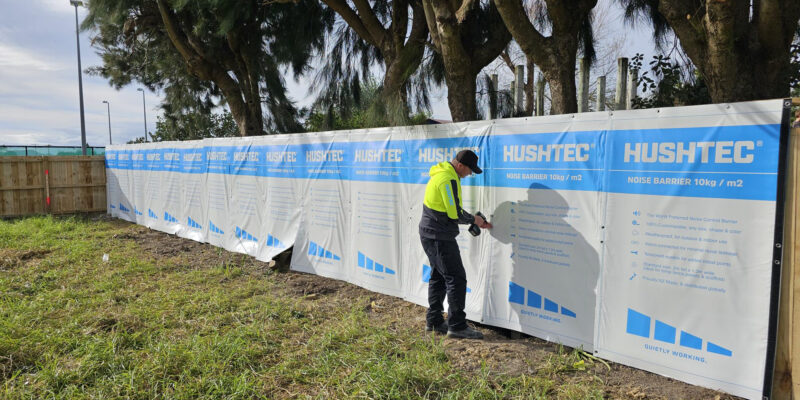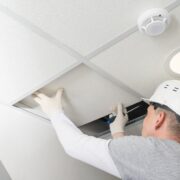Noise barrier sheets, also known as sound curtains, represent a significant investment in the construction and infrastructure sectors. These structures play a crucial role in managing noise pollution, ensuring the comfort of communities and workers alike. To maintain these barriers’ efficacy, professionals must implement stringent upkeep practices.
From regular inspections to specialised cleaning, this listicle will guide you through the essential steps to safeguard a noise barrier sheet for the long haul.
1. Regular Inspection
Regular inspections serve as the frontline defence against reduced barrier effectiveness. By evaluating the condition of your noise barrier sheets, you can identify issues before they escalate, saving you time and money.
What to Look For
An inspection should thoroughly review the barrier’s entirety, paying close attention to signs of wear and tear. Look for peeling, loose parts, or any indication of physical damage that could compromise the barrier’s integrity. Ensure that all components, such as posts and brackets, are secure and functioning correctly.
Recommended Frequency
The frequency of inspections depends on various factors, such as climate conditions, traffic volume, and the barrier’s age. As a general rule, it is recommended to conduct routine checks at least twice a year for optimal performance.
2. Cleaning and Clearing Debris
Dirt and debris can mar the visual appeal of your noise barriers and negatively impact their acoustic capabilities. Regular cleaning is essential to maintain optimal performance. Removing any build-up of dirt, dust, and grime from the barrier’s surface is a must.
What to Use
Avoid using abrasive or chemical cleaners when cleaning your noise barriers, as they can damage the barrier’s coating. Instead, use a mild detergent or a specialised cleaner recommended by the manufacturer. Be sure to rinse the barrier thoroughly after cleaning.
Clearing Vegetation and Other Obstructions
In addition to regular surface cleaning, it is essential to clear any vegetation or other obstructions that may be growing around the noise barrier. Plants can trap moisture against the barrier, leading to corrosion and damage over time. Regularly trimming vegetation and removing debris will help prevent this issue.
3. Repairs and Upgrades
Even with regular upkeep, noise barriers may still require repairs or upgrades to maintain their effectiveness. Promptly addressing any damage can prevent further deterioration and prolong the barrier’s lifespan.
Addressing Physical Damage
If an inspection reveals physical damage to your noise barrier sheet, it is crucial to address it promptly. Depending on the severity of the damage, repairs may involve patching holes, replacing damaged panels, or reinforcing the barrier’s structure.
Considering Upgrades
As technology and materials improve, it may be beneficial to consider upgrading your noise barriers for better performance. For example, newer noise barrier sheet may have increased sound-absorbing capabilities or improved durability.
4. Preventing Water Damage
Water accumulation can be the silent killer of noise barrier life. Proper drainage systems should be in place to divert water away from barrier foundations and surfaces. Standing water can cause corrosion and deterioration, compromising the barrier’s effectiveness.
Clearing Drainage Systems
Regularly inspect and clear any debris or blockages in your noise barrier’s drainage systems. Leaves, branches, and other debris can accumulate over time, preventing proper drainage and causing water damage. Regular maintenance of these systems is crucial for long-term barrier effectiveness.
Waterproof Barriers
Incorporating waterproofing solutions during installation is a strong preventative measure. In conjunction with regular checks, this will help keep water from compromising the sound curtain’s materials.
5. Protecting Against UV Exposure
UV rays can break down the materials over time, leading to decreased sound absorption. Protecting your barriers from sustained sunlight exposure is of the essence. Regular inspections should include checks for UV damage.
UV-Resistant Coatings
Consider applying coatings that ward off UV damage. This is an effective way to extend the life of your noise barriers, especially for those in sunnier climates. Consult with your manufacturer for the best options.
6. Routine Maintenance Schedule
Without a regular maintenance schedule, critical tasks may slip through the cracks. A well-planned schedule ensures every aspect of upkeep is addressed in a timely manner. Consider creating a checklist to ensure all necessary tasks are completed.
Documenting Maintenance
Keeping detailed records of maintenance and repairs can be beneficial in identifying any patterns or recurring issues. It also serves as documentation for warranties, insurance claims, or potential legal disputes.
Setting Reminders
Use digital tools or manual reminders to prompt your team when it’s time for an inspection or routine task. This simple step can prevent any oversight that could lead to a costly repair.
7. Professional Assistance
Sometimes, a task is beyond your team’s expertise. Recognizing when to bring in professional maintenance services can make the difference between a minor fix and a full-scale replacement.
The Pros of Pros
Professional services not only ensure high-quality workmanship, but they also often come with comprehensive warranties that cover any potential issues or defects. This added layer of protection provides peace of mind and guarantees the completed work’s durability and longevity. With the assurance of a warranty, you can have confidence in the reliability and performance of the professional services you choose.
8. Long-Term Effectiveness
Regular upkeep is your best bet at maintaining the functionality of your noise barriers over time. Well-maintained barriers continue to deliver noise reduction at the levels they were designed for.
Extending Lifespan
With proper maintenance and care, the lifespan of your noise barriers can be significantly extended. This saves money on potential repairs or replacements and contributes to a more sustainable and environmentally friendly approach to noise control.
Conclusion
Noise barrier sheets are an asset to any noise mitigation strategy, but they are not immune to natural wear and tear. Regular upkeep not only maintains the peace and quiet of our living spaces but also protects your investment in infrastructure and construction projects. Remember that silence is only as good as its barrier, so let’s shield it well.






Comments